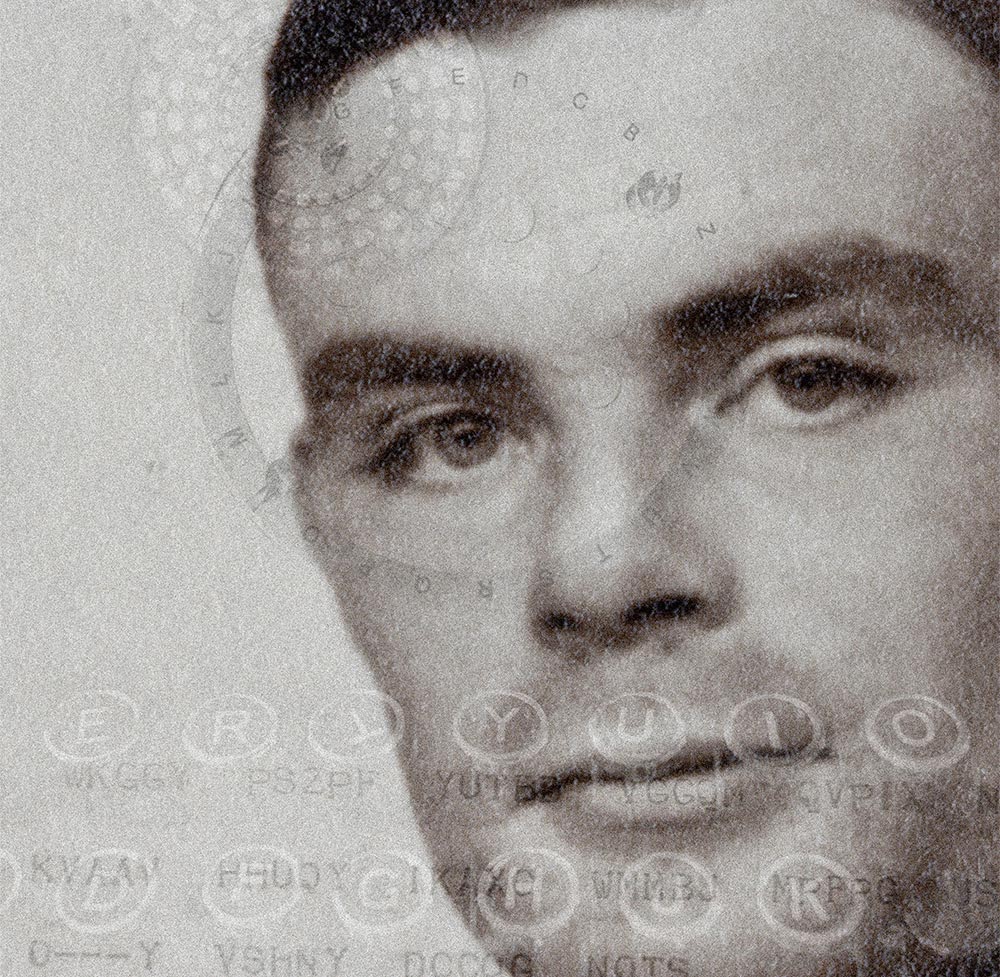TURING a staged case history brings to the stage the thought and work of Alan Turing (1912-1954), English mathematician and logician, cryptanalyst, considered one of the fathers of the computer scienze. The scientific papers of Turing, its algorithms, the documents of the period, produce a stream of processed data put on the scene in real-time. Thanks to specially developed softwares, music and image become languages of the dramaturgical process that lead the multimedia show. Live electronics and live video interact with the word and the body of the actor – Turing was also an excellent runner – in a constant interaction of computing processes of the human and the electronic brain.
The show has managed to put together the game of intelligence and the clash of ideas: inherently dramatic, it is one of the motives of the scientific and conceptual innovation. There is no reason to dramatize further what is already dramatic in itself. Let Turing’s character speak with real Turing words, reconstruct the events with documents, consider the other witnesses to the events, is not only respect for historical truth, but also a way to rediscover the tragic nature of this truth. Giulio Giorello, Philosopher of science
This model, that combines science with art, is probably a great example of modernity and ability to interpret human thought. Luigi Nicolais, President of CNR
The most remarkable of the Turing Centenary events. Barry Cooper, Chair of the Turing Centenary Advisory Committee
GIULIO GIORELLO, PHILOSOPHER OF SCIENCE. THEATER, THEORY AND TURING
LUIGI NICOLAIS, PRESIDENT OF CNR. THEATER AND SCIENZE
DIRECTOR’S NOTE
“Mathematical reasoning may be regarded rather schematically as the exercise of a combination of two facilities, which we may call intuition and ingenuity”. Alan Turing
In 1936 was published On Computable numbers, by the mathematician and genius Alan Turing. He introduced the logical fundamentals of the contemporary digital universe.
This would be a good reason to start a work around his figure: mathematician, philosopher, biologist, visionary architect who anticipated the modern digital worlds and the A.I. concepts, leader of the early electronic calculator projects, code-breaker for the British intelligence during the IIWW and a marathoner runner of near Olympic standard.
His life so full to seem fiction, with all its theatrical features and myths about it and the end with a tragic death, a perfect example of Turing’s undecidability, was a revelation to me.
The reading of Turing’s intense biography written by Andrew Hodges, allowed me to know his complex life and humanity. I’ve kept everything inside me for ten years, until the encouter with AGON, represented by maestro Massimo Marchi who shared my enthusiasm for the project.
Since that moment we’ve started doing researches for the next three years, travelling and looking for Turing documents and places, especially at Bletchley Park, meeting scientists and technology experts, historians, writers, intelligence agents, veterans witness of the IIWW.
Documents and information collected have shown the need to elaborate an artistic work focused on Turing ideas, life, projects and take it on stage with a play made of actions, sounds, words, images, videos and real time data controlled by live performers using machines with software programs developed following Turing’s writings and respecting his essential and extraordinary ability to realize and make the inventiveness complexity of his vision and mathematical logic thought simple with creativity.
I wrote a play, divided into scenes, which is a machine source code to the entire work that can modify itself helped by the presence of the actor, performers and with the concept of time: sudden accelerations, rhythms and speed are metaphors of the brevity of his life, of the historical context and of the new digital time introduced by his researches.
Artists and technology experts called to write music compositions and to work on musical and visual live execution, orchestrated data, logic concepts, and math algorithms and where I feel the necessity to describe life emotions , sounds and images are designed to create a breathe flow; sensorial data back to the memory are represented by sound and video in an immanent sensation. Theater environment is a perceptive extension of the inner space of the actor, whom his body-machine produce emotional variables – breathes, pauses, heart beats, movements – constantly monitored by sensors and re-elaborated and exposed to the audience.
The representation of connections of brain, a will to imitate a human brain and its structures, are the thread of the action, which I found a permanent feature in Turing’s work: he was extraordinary able to simplify the world complexity by his intuition to discover hidden structures in a secret world.
Maria Elisabetta Marelli
MARIA ELISABETTA MARELLI. THE PROJECT
MASSIMO MARCHI. TECHNOLOGY IMPLEMENTATION
MICHELE TADINI. MUSIC
ALESSANDRO BRUNI OCANA. PLAYING ALAN TURING
ROBERTO URBAN.0 BRANCATI. COSTUMES
This content is also available in / Questo contenuto è disponibile anche in : Italian

